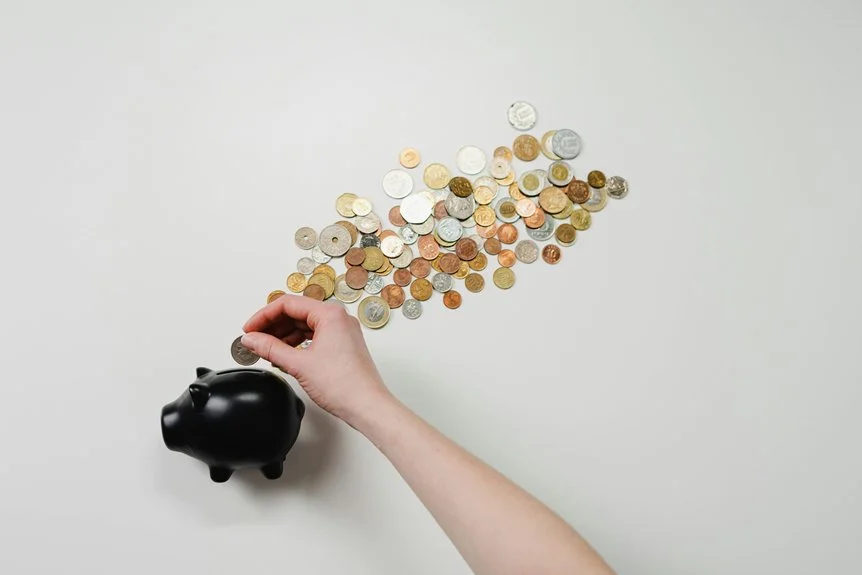
You’re probably throwing away thousands of dollars every year without even realizing it, and honestly, I was doing the same thing until I started tracking where my money actually went. After cutting my family’s annual expenses by over $8,000 through simple lifestyle changes, I’ve learned that living frugally doesn’t mean living poorly—it means being intentional with your spending. Here’s how you can start saving serious money today.
Key Takeaways
- Downsize to one family vehicle to save nearly $9,000 annually in insurance, maintenance, and fuel costs.
- Choose a smaller home to save $5,000-$10,000 yearly in mortgage payments, insurance, and utility bills.
- Cook at home and batch prep meals to reduce monthly food spending by over 50%.
- Shop used items first to save 50-80% compared to buying new products.
- Cancel unnecessary subscriptions and switch to high-yield savings accounts to maximize your money.
Downsize to One Family Vehicle
When I first suggested to my family that we ditch our second car, you’d have thought I’d proposed we start washing our clothes in the river. But here’s the thing—that second vehicle was costing us nearly $9,000 annually in insurance, maintenance, and fuel. That’s money you could used to buy a nice vacation or boost your emergency fund.
After six months of strategic planning, we made it work with one fuel-efficient sedan. Sure, it requires coordination and occasional ride-sharing, but the savings are undeniable. We save money every single month now, and honestly, we barely miss that gas-guzzling SUV.
The key is choosing a reliable used vehicle that fits your family’s actual needs, not your ego’s desires. Consider channeling those vehicle savings into a low-cost business opportunity, as minimal startup investment can lead to significant profit margins and additional income streams.
Choose a Smaller Home Over Square Footage
You don’t need a mansion to feel at home, and choosing a smaller house can slash your monthly expenses by thousands of dollars each year.
When you downsize from that dream 3,000 square foot home to a cozy 2,000 square foot space, you’ll pocket an extra $5,000 to $10,000 annually through lower mortgage payments, cheaper insurance, and reduced utility bills.
Sure, you might’ve to get creative with storage, but your wallet will thank you every month when those smaller heating, cooling, and maintenance costs roll around.
If you’re planning to start a home-based business, creating detailed financial projections will help you determine exactly how much those reduced housing costs can boost your bottom line.
Lower Monthly Housing Costs
Housing costs can easily eat up half your paycheck if you’re not careful, and I learned this lesson the hard way when I was house-hunting five years ago. You’ll save serious money every month by choosing a smaller home instead of chasing square footage that you don’t actually need.
Here’s what downsizing can save you annually:
- $2,000-$5,000 in mortgage interest payments
- $800-$2,400 in property taxes and insurance
- $600-$1,800 in utilities and maintenance costs
I ditched my dream of a massive kitchen island and opted for 1,200 square feet instead of 2,000. Now I’m banking an extra $400 monthly that used to disappear into housing expenses. You can redirect those savings toward investments, travel, or crushing debt faster than you thought possible.
Reduced Maintenance and Utilities
Maintenance costs pile up faster than dirty laundry when you’re dealing with extra square footage you don’t actually use. Every additional room means more windows to replace, more flooring to repair, and more walls to paint. I learned this lesson the hard way with my 2,800-square-foot money pit that demanded $3,000 yearly just for basic upkeep.
Smaller homes aren’t just about saving money on utilities, though you’ll slash those bills too. My friend downsized from 3,000 to 1,500 square feet and cut her heating costs by 60%. That’s real frugal living power right there. Less space means fewer systems breaking down, fewer repairs needed, and more cash staying in your pocket where it belongs.
Opt for a Compact Car Instead of an SUV
You don’t need that massive SUV to haul your grocery bags and coffee cups around town, and your wallet will thank you for choosing a compact car instead. I’ve watched friends save $5,000 to $10,000 upfront by skipping the SUV showroom and heading straight to the compact section, where they found perfectly reliable cars that fit their actual needs.
The real magic happens at the gas pump though, where you’ll fill up your compact car’s tank for 30-40 miles per gallon instead of watching your money disappear at 20-30 mpg like SUV owners do. With the money you save on gas and car payments, you could even start a freelance writing business or other low-cost venture to boost your income further.
Fuel Efficiency Savings
Transportation typically eats up a huge chunk of our monthly budget, and I’ll be honest—I used to think driving a massive SUV made me look successful until I saw my gas receipts. Switching to a compact car changed everything for my wallet.
The fuel savings alone will shock you—you’ll pocket around $1,500 annually compared to guzzling gas in an SUV.
Here’s what makes compact cars financial powerhouses:
- You’ll get 30-40 miles per gallon versus SUVs’ measly 20-25 mpg
- Initial purchase price runs thousands less than comparable SUVs
- Lifetime fuel savings exceed $15,000 over your vehicle’s lifespan
Your compact car becomes a money-making machine every time you drive. That’s serious cash you can redirect toward investments or debt elimination.
Lower Purchase Costs
When I started shopping for my first car replacement, I nearly choked on my coffee seeing SUV price tags—we’re talking $35,000 to $45,000 for a decent model while comparable compact cars sat pretty at $25,000 to $35,000. That $5,000 to $10,000 difference in purchase costs isn’t pocket change, folks. It’s basically a year’s worth of new clothes, vacation funds, or emergency savings sitting right there waiting to be claimed.
You’ll wield serious financial power by choosing the compact option. Instead of stretching your budget thin with hefty car payments, you’re freeing up hundreds monthly for investments or debt payoff. Trust me, your future self will thank you when you’re not drowning in payments for oversized transportation you probably don’t need anyway.
Consider Renting Instead of Buying
Although homeownership feels like the ultimate American dream, I’ve learned that renting can actually be the smarter financial move in many situations. When I crunched the numbers, I discovered that buying my dream home would’ve cost me $2,400 monthly between mortgage, insurance, and maintenance. Instead, I’m renting for $1,800 and investing that $600 difference in my savings account and paying off credit cards faster.
Renting might give you more financial power:
- Flexibility to relocate for better job opportunities without selling hassles
- No surprise repair bills that can drain your emergency fund overnight
- Lower upfront costs mean you’re not tying up $40,000+ in a down payment
You’ll maintain more control over your finances and keep your options open. Plus, renting frees up your time and mental energy to focus on building home-based businesses that can generate additional income streams.
Shop Used Before Buying New
My biggest money-saving discovery happened when I stopped automatically heading to Target for everything I needed. Instead, I started checking secondhand stores first, and honestly, it’s been a game-changer for my wallet.
You can save 50-80% on used items compared to buying new, which adds up fast. I’ve found barely-used furniture, electronics, and household goods at garage sales and online marketplaces for pennies on the dollar. Last month alone, I saved $300 by buying a used coffee table instead of a new one.
The key is making this your default habit. Before clicking “add to cart” anywhere, spend ten minutes browsing Facebook Marketplace or hitting up local thrift shops. You’ll be amazed what quality stuff people sell. This mindset of starting small and reinvesting profits can even translate into entrepreneurial opportunities if you discover valuable items to resell.
Cook More Meals at Home
Since discovering the magic of home cooking, I’ve watched my food budget shrink from $800 a month to just $350, and honestly, I’m eating better than ever.
Home cooking slashed my monthly food spending by more than half while dramatically improving my meal quality and health.
You’re probably spending way too much on convenience foods and restaurant meals. I used to grab lunch out daily, dropping $8-12 each time. Now I pack homemade meals and save $150 monthly just on lunches.
Here’s what transformed my grocery store strategy:
- Plan three meals you can batch cook on Sundays
- Buy basic ingredients instead of pre-made convenience foods
- Learn five simple recipes you actually enjoy eating
Start with easy wins like pasta dishes, stir-fries, or sheet pan meals. A slow cooker makes high-protein meals incredibly simple – just throw ingredients together and let it do the work while you focus on other things. YouTube taught me everything I needed to know, and within two months, I’d mastered enough recipes to ditch takeout completely.
Use Smart Strategies When Dining Out
Look, I’m not going to pretend I never eat out anymore—that would be completely unrealistic and honestly, pretty miserable. But you can absolutely be more frugal about it without sacrificing the experience.
First, pay attention to timing—avoid peak dinner hours when restaurants jack up prices. I’ve saved 20-30% just by eating at 5 PM instead of 7 PM. Download every restaurant app you can find; they’re goldmines for coupons and deals.
Split entrees with your dining partner—portions are ridiculously oversized anyway. Order water instead of paying $3 for a Coke that costs them thirty cents. Some places even let you bring your own drinks. These small changes add up to serious savings over time.
Consider bringing a steel water bottle to restaurants that allow outside beverages, which can save you even more on drink costs while keeping you hydrated throughout your meal.
Pack Your Lunch for Work
You’re probably spending way more on lunch than you think, and I learned this the hard way when I calculated that my daily $12 sandwich habit was costing me over $3,000 a year.
The good news is that packing your lunch doesn’t have to mean sad desk salads or hours of prep work, especially when you find the right rhythm for meal planning and discover which healthy ingredients give you the biggest bang for your buck.
Start your day with a protein-rich breakfast like Greek yogurt parfait or overnight chia pudding to keep you satisfied longer and reduce the temptation to splurge on expensive mid-morning snacks before lunch.
Let’s break down how to calculate your real savings, streamline your prep process, and choose filling options that won’t drain your wallet or leave you hungry by 3 PM.
Calculate Your Daily Savings
The arithmetic behind packing your lunch might shock you more than your morning alarm clock. When you bring your own meals, you’re not just saving pocket change—you’re boosting your cash flow by thousands annually. That $10 daily lunch habit costs you $2,500 yearly, while homemade meals run about $2-$4 each.
Daily impact: $6-$10 back in your wallet every workday
Monthly power: $130-$215 extra for investments or debt payoff
Annual advantage: $1,500-$2,500 toward your financial goals
Add coffee savings, and you’re looking at $3,750 annually. That’s serious money that could fund an emergency fund, vacation, or retirement contribution. The math doesn’t lie—your lunch choices directly impact your financial future.
Prep Meals in Advance
Once you’ve seen those shocking lunch numbers, meal prepping becomes your secret weapon against financial drain. You’ll transform a few weekend hours into $2,000+ annual savings, and honestly, it’s easier than you think.
Start by cooking larger batches on Sunday – think chili, stir-fry, or pasta dishes that portion beautifully. Grab some reusable containers and divide everything into grab-and-go servings. Make sure you plan your weekly menu first, so you don’t wander the grocery store aimlessly like I used to.
The beauty? You won’t need to stress about “What’s for lunch?” anymore. No more cafeteria markups or restaurant temptations. Just open your fridge, grab your prepped meal, and walk out the door feeling financially victorious.
Choose Healthy Budget Options
When you’re standing in that office break room at 12:30 PM, staring at your sad desk drawer filled with emergency granola bars, smart lunch choices become your lifeline to both health and wealth. Packing your lunch isn’t just about being frugal in every aspect—it’s about taking control of your financial future.
You’ll save an average of $2,000 annually by ditching those $12 takeout meals.
- Use Sunday’s leftover chicken dinner for Monday’s sandwich
- Bring a refillable water bottle instead of buying $3 drinks
- Prep five lunches at once to save weekend time
When you live a more frugal lifestyle, you control portions, ingredients, and costs simultaneously. Your wallet and waistline will thank you.
Build a Minimalist Wardrobe
Building a minimalist wardrobe might sound scary if you’re someone who owns thirty different black shirts (guilty as charged), but it’s actually one of the smartest money moves I’ve ever made. You’ll take care of your finances while creating a system that works beautifully.
Here’s my go-to formula for building power pieces:
| Category | Quantity | Colors |
|---|---|---|
| Blazers | 2-3 | Navy, Black, Gray |
| Pants | 4-5 | Black, Navy, Gray |
| Shirts | 6-8 | White, Blue, Solid Colors |
| Shoes | 3-4 | Black, Brown, Versatile |
| Accessories | 5-6 | Neutral Tones |
This approach helps you curb impulse buying while creating countless outfit combinations. I sold my excess clothes for $800 last year, then invested in quality pieces that’ll last years instead of months. When you’re ready to expand your wardrobe, consider supporting ethical apparel brands that prioritize sustainability and fair labor practices over fast fashion alternatives.
Eliminate Online Impulse Purchases
Most likely, you have found yourself clicking “buy now” at 2 AM on some random gadget you’ll never use, and trust me, we’ve all been there.
The secret to breaking this expensive habit lies in two simple strategies: creating 30-day wish lists and removing your saved payment information from every shopping site. These small changes create just enough friction to make you pause, think twice, and realize you don’t actually need that third coffee mug with a funny saying on it.
For entrepreneurs managing multiple online purchases, tools like Zapier can help automate tracking of your spending patterns by connecting your shopping apps to spreadsheets, making it easier to see where your money actually goes each month.
Use 30-Day Lists
Although scrolling through Amazon at midnight might feel like harmless window shopping, I’ve learned the hard way that it’s basically financial quicksand. You’ll waste so much money on stuff you don’t actually need if you keep browsing for entertainment.
Here’s my game-changing strategy that’s saved me thousands: create a 30-day want list. Every time you feel the urge to buy something non-essential, write it down instead of purchasing immediately. Wait exactly 30 days before revisiting that list.
This simple pause gives you:
- Time to evaluate whether you truly need the item
- Opportunity to research better alternatives or prices
- Space to recognize impulse purchases before they happen
Trust me, most items on your list will seem completely ridiculous after a month passes.
Remove Saved Payment Info
The fastest way to sabotage your budget is keeping your credit card info saved on every shopping website you’ve ever visited. Those “convenient” one-click purchases aren’t doing your wallet any favors – they’re costing you serious money.
People spend 18-40% more when they can buy things with a single click versus entering payment details manually. That’s hundreds, maybe thousands of extra dollars you’re hemorrhaging annually because you wanted checkout convenience.
Take control by deleting your stored payment information from Amazon, eBay, and every other retailer. Disable one-click ordering everywhere. Force yourself to manually enter credit card payments each time. Yes, it’s slightly annoying, but that friction is your friend. Those extra thirty seconds give your brain time to ask, “Do I actually need this?”
Switch to a High-Yield Savings Account
Banking on traditional savings accounts feels like watching paint dry – except the paint somehow gets duller over time. You’re literally losing money to inflation while banks profit from your cash.
Traditional savings accounts are financial quicksand – your money sinks deeper into irrelevance while banks get richer off your complacency.
High-yield savings accounts currently offer interest rates over 3%, crushing the pathetic national average. Moving just $10,000 from your dusty traditional account to a high-yield option earns you hundreds more annually. That’s real money working for you, not against you.
Here’s what makes these accounts unstoppable:
- No minimum balance requirements or monthly fees
- Interest rates that actually matter for your emergency fund
- Simple online setup through banks like Ally or Marcus
Stop letting banks feast on your hard-earned money. Switch to a high-yield account and watch your emergency fund grow automatically.
Cancel Unnecessary Subscriptions and Services
While you’re maximizing your savings account, you’re probably bleeding money through a dozen forgotten subscriptions that auto-renew like vampires in the night. I discovered I was paying for three streaming services I hadn’t used in months, plus a gym membership collecting dust since January.
Start your frugal lifestyle transformation by reviewing every monthly charge on your bank statement. Cancel underutilized streaming services, magazine subscriptions, and that premium cloud storage you don’t need. You’ll easily save $50-$100 monthly just from ditching landline phones and cable TV.
Don’t forget your cell phone plan – downgrade to basic service without excessive data. Unsubscribe from shopping websites to avoid impulse purchases. Renegotiate insurance and utility rates, or switch providers entirely. These simple moves can save you hundreds annually.
Shop Your Home First Before Buying
Before you click “add to cart” on that kitchen gadget you desperately need, raid your own house like a treasure hunter first. You’d be shocked at what’s hiding in your closets, drawers, and forgotten corners. I saved $200 last month by finding a perfectly good blender buried in my pantry cabinet.
Take a complete inventory before shopping to avoid buying duplicates. Set up a 30-day waiting period for non-essential purchases to kill impulse buys. Hunt through storage areas for items you can repurpose instead of buying new.
When you need something, those little things add up fast if you’re not careful. Check your basement, garage, and that mysterious junk drawer first. You’ll become your own personal shopping mall.
Compare Insurance Rates Annually
Insurance companies aren’t loyal to you, so don’t be loyal to them when it comes to your wallet. I used to stick with the same provider for years, assuming loyalty would come back to reward me. Spoiler alert: it didn’t.
Now I highly recommend reviewing your auto, home, and life insurance annually. Last year, I saved $800 by switching car insurance and bundling it with my homeowner’s policy. The whole process took maybe two hours of comparing quotes online.
Here’s my simple strategy: raise your deductibles if you’ve got emergency savings, adjust coverage when life changes, and always get quotes from at least three companies. Your current insurer will suddenly find “discounts” when they realize you’re shopping around.
Practice Strategic Grocery Shopping
Since grocery bills can devour your budget faster than a teenager raids the fridge, I’ve learned that strategic shopping isn’t just helpful—it’s essential. You’ll be able to save hundreds by planning your weekly meals before stepping foot in the store. I make my shopping list based on what’s already in my pantry, then stick to it religiously.
Strategic meal planning before shopping isn’t just smart—it’s the difference between saving hundreds and watching your budget disappear.
Here’s my battle-tested approach:
- Download price comparison apps like Flipp to find the best deals across multiple stores
- Use store loyalty programs and stack manufacturer coupons for maximum savings
- Buy non-perishables in bulk when they’re 30% off or more
Shop the store’s perimeter first—that’s where fresh, whole foods live. Trust me, avoiding those tempting center aisles saves both money and willpower.
Conclusion
You don’t need to tackle all fifteen tips at once – that’s overwhelming, and honestly, you’ll probably give up. Start with three easy ones like canceling subscriptions, shopping your home first, and comparing insurance rates. These changes alone could save you $2,000+ annually without major lifestyle shifts. Once you’ve mastered those, gradually add more strategies. Recall, you’re building long-term habits, not running a sprint toward financial freedom.





Leave a Reply